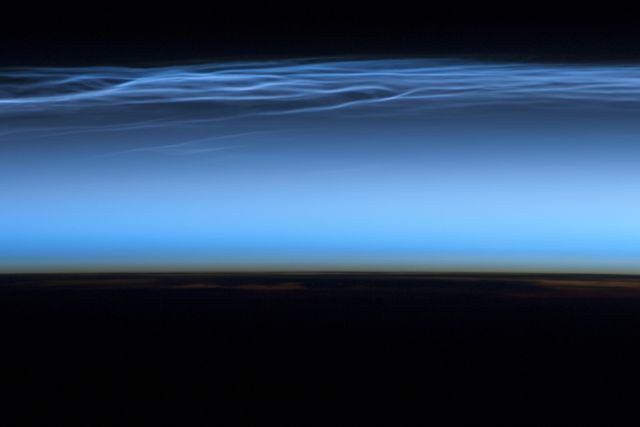
When astronaut was what his favorite photo taken during the first three weeks of a stint on the International Space Station was, he answered simply.
“I love the beautiful pictures of the world,” Hadfield , “but for
me, the one that was most significant was looking at the noctilucent clouds.
These are clouds that you can barely see from the surface of the Earth.
They're the highest clouds that exist—tiny ice particles way up in
the mesosphere. And yet from orbit, as the sun rises, the light bounces
off of those clouds, directly into our eyes—and we can see a part of
the Earth's atmosphere that's basically invisible to people on the
surface. To me, that's both beautiful—because of the colors and
textures and ripples of it—but it's also really significant. It's a
way to understand the changes in our atmosphere, and a way to understand
exactly how our atmosphere interacts with the universe beyond.”
What exactly did Hadfield mean by that last sentence, in which he says that the clouds can help us understand changes in our atmosphere and our relationship to the universe? I set off in search of the science behind noctilucent clouds for the answer.
An posted by NASA in August 2012 explains a lot. The connection of the clouds to the universe is fairly simple. “We've detected bits of 'meteor smoke' embedded in noctilucent clouds,” said of Hampton University, the principal investigator of
NASA's mission to study the phenomenon. “This discovery supports
the theory that meteor dust is the nucleating agent around which NLCs
(noctilucent clouds) form.”
Meteors burn up in the earth's upper atmosphere, between 43 to 62 miles above the surface. The dust from the smoke that's left behind acts as a gathering point roughly 51 miles above the earth. Water, snowflakes, and ice glom onto the dust and form clouds. The resulting crystals are small, roughly one-tenth to one-hundredth the size of the particles that form in cirrus clouds lower in the atmosphere. The size explains the brilliant blue color—smaller particles tend to scatter more blue than red light down to earth.
Scientists believe noctilucent clouds have a different distribution today than they did in the 19th century. The good news for people in the United States is that the clouds can be seen at lower latitudes. A few centuries ago, they were more common over high latitudes like Canada and Scandinavia. Now, they can be seen hovering over Colorado and Utah. The bad news is that Russell believes the change in distribution is a result of . He said an increase in methane in the upper atmosphere since the 19th century may have led to the lower occurrence of the clouds. “When methane makes its way into the upper atmosphere, it is oxidized by a
complex series of reactions to form water vapor,” he said. “This extra water
vapor is then available to grow ice crystals for NLCs (noctilucent clouds).”
For more background about the formation of noctilucent clouds, watch the video below.
For more on astronaut Chris Hadfield, and to see his picture of a noctilucent cloud, read this article from .
—Joe Spring